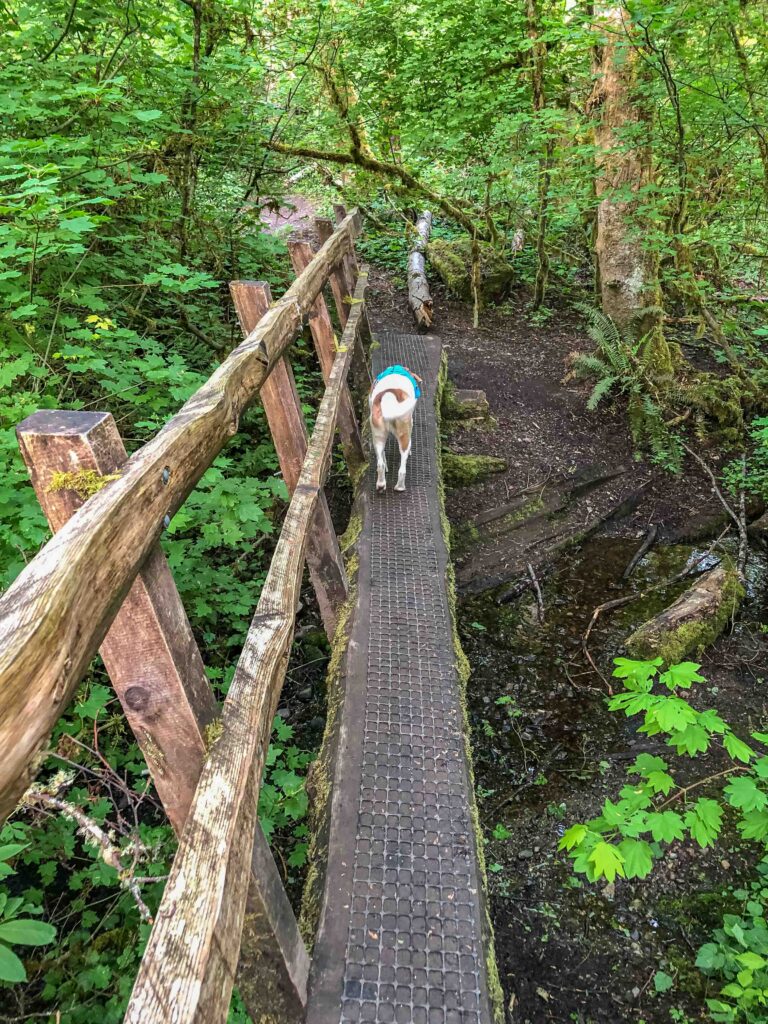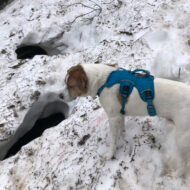Tuesday morning, Ajax and I explored 7.5 miles of trails on Cougar Mountain. One of the things I love about both Tiger Mountain State Forest and Cougar Mountain Regional Wildland Park with its 35 miles of winding trails is the opportunity to explore lots of different areas of the park. Our ramble gave me three hours to reflect on my Master Health Coaching class through Precision Nutrition. In particular, I wanted to think about the many ways to help clients assess progress.

My intentions shortlist included the following three items:
- Reflect on the use of objective and subjective data for assessing client progress
- Explore new-to-us segments of Cougar Mountain’s trail system
- Test two new water delivery systems I’d purchased for Ajax’s 8th birthday
Assess Progress: Objective vs. Subjective Data
During our hike, I found myself thinking about how Precision Nutrition suggests tracking progress. To help clients reach distant mountain peaks, there are some obvious, objective metrics. Guide services such as Alpine Ascents International want to be sure their climbers can reach base camp carrying a specific pack weight in a certain amount of time. If not, they might jeopardize the team’s chance to reach the summit.
Objective Data
Objective measurements include measurable facts such as:
- Distance hiked
- Elevation gained or altitude attained
- Time traveled
- Pack weight carried
- Heart rate data (average, max, rate of recovery)
- Steps achieved using some biometric device such as an Oura ring, Whoop strap, or Fitbit

Subjective Data
But these metrics are only part of the picture. For some people participating in unguided trips where they can take their own time, subjective metrics may actually be more important. These might include:
- Feeling less winded at the top of stairs or hills
- Having energy for the trip back to the car
- Wanting to eat at base camp or the summit
- Feeling well enough not to need any pain medication or anti-inflammatories during or after the trip
- Being able to recover quickly once exercise stops
- Feeling like they can continue the very next day without much rest
- Have a conversation with a partner on the way up or down
- Having an easier time than the previous hike
Subjective data are harder to quantify. They are specific to each person and based more on internal feelings rather than external metrics. Such criteria often have more meaning for the hiker.

Assess Progress Using a Continuum
If something can’t be measured, how exactly do you gauge improvement? The short answer is: scaling, or using relative comparison on a continuum.
Take the first example given in “subjective data.” If you do a hike one week and it takes you fifteen minutes of sitting on a rock, panting, at the turn-around point before you feel like you can start again, and the next week it only takes you five minutes (for similar effort/exertion), and you stand for most of that, you have shown “much improvement.”
Whether you use a scale of 1 to 3, 1 to 10, or 1 to 100 doesn’t matter so much. And the exact number (which would mean you’re looking at objective data) also may not matter. What matters is feeling better than last time for comparable effort. We’re after improvement.
How do you track your own progress? Is your way helpful? Or do you beat yourself up over a higher-than-expected heart rate and slower-than-desired pace? Could you use a better way to gauge improvement? One that matters to you?
Water for Ajax
For several years, I’ve been providing Ajax treats on the trail in a collapsible silicone food and water bowl, but the ribs have collected some unidentifiable, unappealing substance that won’t scrub off. Ajax deserves better. For his eighth birthday, I bought several hydration systems for us to test.
A plastic Lesotc 2022 allows the remaining water to return to the bottle. It comes with a mini-carabiner for attaching to your pack. One fatal design flaw requires sticking your fingers into the water to secure a plug after filling the cup. I opted to maintain squeeze pressure while he drank. Unfortunately, when I let go mid-lap, the slurp of the draining water startled him. Product fail.

The second was a Gology insulated 32-ounce thermos, complete with a carrying case, detachable food and water bowls, a slot for a phone or wallet, and a screw-on cup. The unit is completely dishwasher compatible, which was my main objection to the silicone bowls. But at two pounds, I’m still skeptical. The verdict? You might have guessed. Ajax prefers running water from a stream.
Assess Progress During Exploration
Having successfully tested the two hydration systems, our third objective was to explore the park. Once you know the main route in any park, it’s fun to get off the beaten path and see what else the park or mountain has to offer.
Our route took us up Big Tree Ridge Trail for about a mile (in the northeastern-most corner of the park marked by “You are Here”). We immediately turned left and wandered along the following trails: Military, Precipice Top, Surprise Creek, No Name, Shangri-La, Protector, Tibbetts Marsh, Cougar Pass, Klondike Swamp, Lost Beagle, and finally ended up at the parking lot at the Harvey Manning Trailhead.

Solace and Problem-Solving
The wonderful thing about starting a hike midweek at 6 a.m. is — you guessed it — solitude! We shared the trail with two trail runners, a pair of women hikers starting as we finished, 19 bird species, a mole, a mouse, squirrels, and a chipmunk.
But perhaps one of my favorite reasons to hike is to give my brain a rest from helping guide clients solve challenging problems. Hiking becomes a form of walking meditation. I may start using the subjective metric of “feeling emotionally better at the end of a hike than when I started.”
May all of you find solace in your own exploration. And if you have a metric you use that I haven’t written about here, please share so we can all benefit.


An interesting angle on a different way to measure “gain” in our outdoors adventures. Having been born and raised on the supremacy of data over feelings (Ha! Ha! Ha!) I spent much of my early hiking days gathering as much of that data as possibly to determine if I was improving or not. These objective metrics just fit so nicely into my love for planning my outings and then, once back at home, making sure that I met all my objectives. It worked… to a point. Often, my feeling of “accomplishment” quickly dissipated and a desire to do even better took its place. I was addicted to the rat race; one where my competitors were just my earlier selves – a rate race, nonetheless. I eventually realized that I had a lot of fun planning, quite a bit of fun reviewing my successes as downloaded data showed beautiful graphs proving I had done better than last time… but I had in fact less fun hiking day after day with the sole (or at least main) purpose of “giving it the best I had”. I was missing countless opportunities to appreciate my surroundings, to bathe in the peace of the forest, to look inside and quiet down the chatter. Now my alternate metrics include “have I often enough slowed down or stopped to enjoy where I was (instead of being laser focused on where I was headed)?”, “have I felt a deep peacefulness, a centering of the soul?”, “have I taken unplanned detours because they seemed promising”, “what did I remember of the day when I lay down in my tent at night?”. Additionally, a special category of “progress” is now dedicated to the quality of the decisions I made when faced with unexpected challenges. I recently was faced with such a dilemma: on day 2 of a five days backpack, my hiking companion showed unmistakable signs of a non-trivial illness; we debated the wisdom of continuing our trip as there were exit points ahead of us; we had talked so much about the trip and were so looking forward to it; maybe she could continue one or two more days… but it was clear that she could not make it to “the end”; we opted for an abort and a return to the city were she could be seen and helped. I consider that decision a great sign of progress.
Thanks for the reflections, Gerard. Indeed, as we gain more experience I think we also gain more wisdom, compassion, and insights into what matters. Your post points to looking for peace, exploring new things, taking time to smell the roses, and finding the moments that matter. Because in the end, we don’t remember days or whole trips, we remember moments that stand out. For me, over a 6.5 week trip to Europe when I was in my early 20’s, taking a day-long detour OFF our very detailed agenda to explore Lac Trasimeno “because it was there and looked inviting” was one of the things I still remember well. Go figure. So take those detours. Stop the watch. Go with the bliss in the moment. I hope your friend is okay!
I stop using typical tracking metrics a few years ago when I stopped going on expeditions with other people.
Since then, I have embraced solo hiking and backpacking, I only tracked distance and time of my hikes to ensure I am fit enough to complete my hiking/backpacking adventures.
One subjective metric is my level of happiness before and after my hike. It’s always higher after than before. 😍
Life is always better outside.
I love your subjective metric! And yes, the only time your last statement doesn’t ring true is when wildfires are polluting the air. Then I take cover inside. But any other time — including and especially snowstorms — I like getting outside. Fresh air rocks!